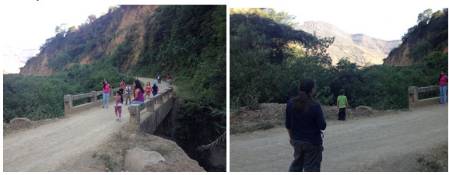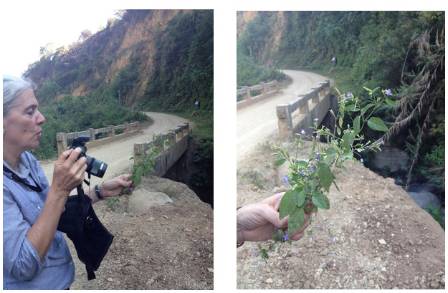I have been away alot recently (that sounds familiar to all that know me) and one of those trips was a field trip to Peru. In fact I brought my partner with me to be our driver and field assistant. This is a big gamble - would we be able to cope without killing each other; would he understand and enjoy what we were doing; would he drive us off the cliff? These were all considerations that we pondered but eventually decided that it would be great - if we couldn't explain to him the value of our work then we reallly needed to work on our communication skills.
However it wasn't a holiday for him - as well as the driving we made him press plants, collect insects, take DNA samples, transcribe field data and also I made him write my blog . There was a lot so he will be doing it in instalments as he also has a day job . It has been enlightening reading it and seeing what we do through the eyes of another.
Without much further ado, I give you Dave:
For reasons best known to herself, The Doc thought it would be a good idea for me to come with her to Peru for two weeks as her field assistant/driver/Odd Job man. Part of the deal was to see if I could write her blog for a few days. Folly! The idea is that I might provide an outsider's perspective on what Erica does, as prior to this I had little experience with fieldwork beyond high-school geography. So I gave up two precious weeks of holiday and relented.
I've never been to South America. It's not something you pass up. I paid the air fare, but much of the (admittedly inexpensive) rest came free. As an editor in my job, at the very least this would be an opportunity for me to ask some awkward questions! So I'll be filling in for Erica and revealing what she and Dr Sandy Knapp, botanist extraordinaire and leader of this expedition, find in Darkest Peru (© Paddington Bear).
The gang.
It took 20 hours of flying and 14 hours (más o menos) of driving to get our first sample, so let it be known that the Museum goes far for our money. We were joined by two wonderful spirits of the insect and plant world: Evelyn Gamboa of the entomology dept of the University of San Marcos in Lima (the oldest in the Americas) and later by botanist Segundo Leiva Gonzales, Director of the herbarium at Antenoar Orrego University in Trujillo.
First question: what are we doing here? Is it worth it? Is this some sort of jolly? I'd suspected Erica led a charmed life coming on these trips, which she called work. But I had to keep an open mind. So of course we're here to collect plant and insect samples. Specifically it's plants of the Solenacaea family (i.e. nightshades - wild relatives of our cultivated tomatoes, aubergines, potatoes and tobacco) - and the pollinators, pests and associated microfauna thereof. In particular, we'll be collecting diptera - true flies, which you'll all by now know about already if you follow Erica's blog.
Sandy says this is the first study we know of that samples both the plant and associated insect population together, in situ. The success of this trip - or otherwise - could have extensive repercussions for future study. Naturally, this trip will also add to the Museum's (and by extension, the world's) knowledge of these species, and will boost Segundo's university's collection. We'll also be able to tell what's happening to the distribution, prevalence and range of these species over time (many records go back decades).
And the data they find here could have a wide variety of applications. For example, a changing climate might put stress on current cultivars of tomatoes. Crossing these staples with certain varieties of their hardier Peruvian cousins might increase pest resistance, or tolerance to drier conditions for instance - agricultural benefits with with knock-on effects for food security, natural pest control, biodiversity and species distribution.
But, before all that can happen, we had to find them first. That meant a day of driving up the Panamericana north from Lima. We had the right car for it - a 4x4 Toyota the crew likes to call Freddie. It is owned by a man called Martin, who has never learned to drive it. I will be happy to test-drive it on this occasion. I will not be calling it Freddie...
Dave and Freddy.
Away from the sprawl of the capital
Once Freddie had escaped the sprawl and grubby winter permafog of the capital, we hugged the coast up the Panamericana and the fog lifted. The scenery slowly evolved from apocalyptic ashen desert into drifting caramel dunes, lonely pastel mountainscapes and roads that vanish on the horizon. We stopped in a roadside café made of reeds with a toilet located tellingly far from the main building that had no water, no toilet paper - but did have a colourful penguin collage painted optimistically on the outside. Yet here they served us the freshest and tastiest ceviche - perfect fodder when the thermometer is climbing above 30degC.
We spent that evening in Trujillo, where the crumbling colonial mansions and old courtyards of the old town seemed to me to be a vast improvement on what I'd seen of Lima at that point (which to be fair, was not much). Yet I felt I had been in the country for some time - a result of that temporal illusion you get when you're a bit jetlagged and you've crammed so much into a short period. But as Erica and I shared a beer at the end of a dusty day, I realised we hadn't even taken our first sample.
At 6.30 the next day we were off. We headed north again on the Panamericana and after an hour or two, turned right towards the distant mountains, roughly following the river Chicama. After a brief stop for grub in a charming market village called Roma we wound our way up a dry valley interspersed with fertile arable land into the foothills of the Andes. The dunes had given way to scrub - semi desert - where stately cacti pointed skyward and the road deteriorated into a dirt track full of entertaining potholes (n.b. not entertaining for everyone in the car). We stopped occasionally to sample the plants, and Erica showed Evelyn the ropes of how to collect with nets and Erica's primary weapon - the suction sampler. Basically this is a handheld vacuum cleaner with a net and container for catching the insects. Anyone wielding it looks like That Fourth Bloke in Ghostbusters. It looks daft, but it does its job. Vultures hovered hopefully in the blue as we inched inadvisably on.
The variety of landscapes.
Hours of lurching later, Sandy bade us stop at a loop in the road, an unconvincing turnoff to a place called Colbot, having seen a likely candidate. Her instincts were correct - a single specimen of Solanum habrochaites clung defiantly to a cleft in the bend. This is a wild tomato species that is found on the western slopes of the Andes from central Ecuador to central Peru. This species is notable partly because, with a bit of crafty crossbreeding, it yields 20 times more sugar than the cultivated tomato - a matter of keen interest to the Heinz family.
Erica and Evelyn got out and swept their nets gamely - Erica performing a more detailed local sample and, as had been decided, Evelyn with a more free role, performing a general sweep in all the sites we encountered. Sandy cropped herself a small sample when they'd finished swishing. Here Erica discovered a beefly among the other unfortunate captives in her killing jar. As we know, Erica gets soppy about beeflies. But not so soppy as to let them go.
Segundo took a sample of Capparis scabrida - a relative of the caper plant - sprouting in the dry riverbed. Then Erica and Evelyn swept the hell out of this area with their nets and Erica seemed interested to have caught a micropezidae - stalky, stick-legged flies, which she feels are "quite funky".
We stopped for lunch here. A local cowherd came and joined us and he told us that there hadn't been any rain that year, and that it was making life difficult. I can but try and imagine. I was finding it hard to believe we would find much in this environment. But not for the first time I would be proven wrong.
Life finds a way
A single mototaxi - a tuktuk - wobbled past us carting an old lady, probably from the market in Roma. We'd passed it several times and when we'd stopped to look for specimens and it had crawled past us, the tortoise to our hare.
The 'tortoise' to our hare
The vegetation became more abundant, as the road gathered height, along with my spirits. Not that I wasn't fascinated with the desert but, given a choice, I much prefer the mountains and greenery to deserts, and the scenery was becoming more and more preferable.
Several stops and samples later, we made a final stop in a bend where a stream passed under the road a mile on from a charming mountain village called San Benito. This location was teeming with life. Humans included. Children from the nearby village came to say hello, all curious to see what these gringos were doing on their patch. All except one young lad, who was having a bad day and preferred to throw stones at his friends. For this, his big brother took him home upside down.
Where there's water
Meanwhile, we swept for various insects, and I carried on my supplementary job of detailing the GPS location, weather conditions and general description of the sample site. I was also given the seed-collecting detail. Lots was found here.
Sandy found three different kinds of wild tomato and then casually announced she had discovered a new species of Browalia - a Solanacaea species sometimes grown ornamentally like petunias. This was something I found astonishing but to the experienced botanist, it was merely very interesting. And Erica discovered a few snail-killing Scyomyzids -the presence of moist liking flies was presumably testament to the damper conditions.
After an hour or so of sweeping, the mototaxi pottered round the corner, passed us again and disappeared round the corner for the last time.
Colourful buildings of San Benito.
After a welcome supper in a very rustic kitchen in San Benito, where Segundo secured us berths in a municipal hotel, Erica and Evelyn started pinning the specimens, Sandy set up her plant-dryer - an insulated stack of card and wood heated overnight by a small gas flame - and I started logging the samples we had found on Erica's ancient laptop. By the time we had finished it was time for bed.
But first I felt I should at least reacquaint myself with the night skies of the southern hemisphere and say hello to the Southern Cross. I avoid the overused word 'awesome' if I can, but it seems perfectly fitting here. I've never seen the stars quite as clear as that night in San Benito. I thought I had made some sort of mistake - but no, it wasn't low cloud, but the distinct ghostly veil of the Milky Way. '
To be continued....
So that was Dave's first thoughts on fieldwork with us..More blog pieces to follow....











